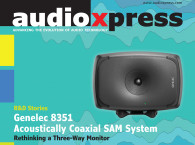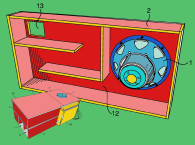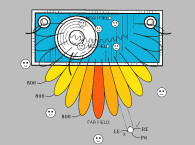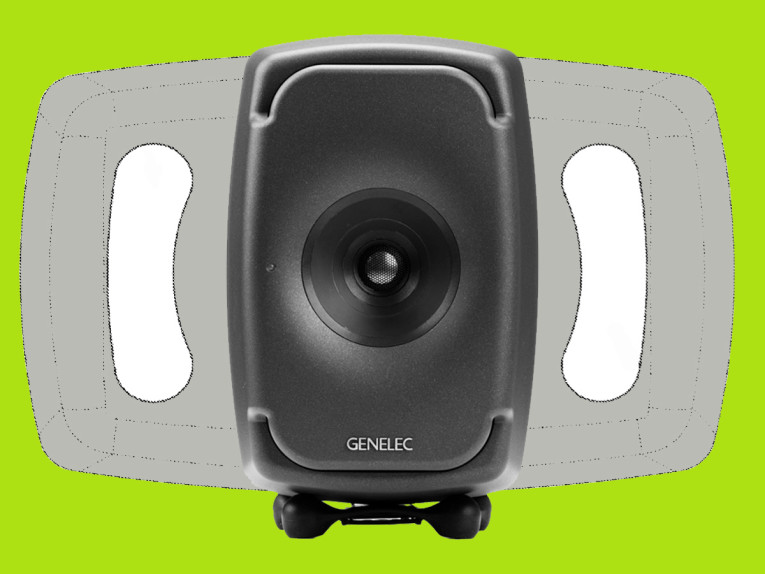
Loudspeaker with a Wave Guide
Patent Number: US20140369543
Inventors: Jussi Vaisanen (Iisalmi, Finland); Ilpo Martikainen (Iisalmi, Finland)
Assignee: Genelec
Filed: June 16, 2014
US Classes: 381/338
Published: December 18, 2014
Number of Claims: 20
Number of Drawings: 4
Abstract from Patent
The present invention relates to a loudspeaker including a first driver, which is configured to produce a first frequency band and a corresponding first acoustic axis, a second driver, which is configured to produce a second frequency band, which is different from the first frequency band but may overlap in a crossover region, and which second frequency band has a second acoustic axis, and an enclosure enclosing said drivers and comprising a three dimensional wave guide positioned on a front surface of the enclosure and around the first driver (see Figure 1). In accordance with the invention the three-dimensional waveguide comprises an acoustically selectively transparent portion which is acoustically essentially reflecting to sound waves of the first frequency band propagating in a direction angled to the first acoustic axis, the waveguide portion is essentially transparent to sound waves of the second frequency band propagating in the direction of the second acoustic axis through the waveguide portion, and in that the second driver is positioned inside the enclosure behind the acoustically selectively transparent portion.
Independent Claims
1. A loudspeaker including a first driver, which is configured to produce a first frequency band and a corresponding first acoustic axis, a second driver, which is configured to produce a second frequency band, which is different from the first frequency band but may overlap in a crossover region, and which second frequency band has a second acoustic axis, and an enclosure enclosing said drivers and comprising a three dimensional wave guide positioned on a front surface of the enclosure and around the first driver, wherein the three-dimensional waveguide comprises an acoustically selectively transparent portion, which is acoustically essentially reflecting to sound waves of the first frequency band propagating in a direction angled to the first acoustic axis, the selectively transparent portion is essentially transparent to sound waves of the second frequency band propagating in the direction of the second acoustic axis through the selectively transparent portion, and in that the second driver is positioned inside the enclosure behind the acoustically selectively transparent portion.
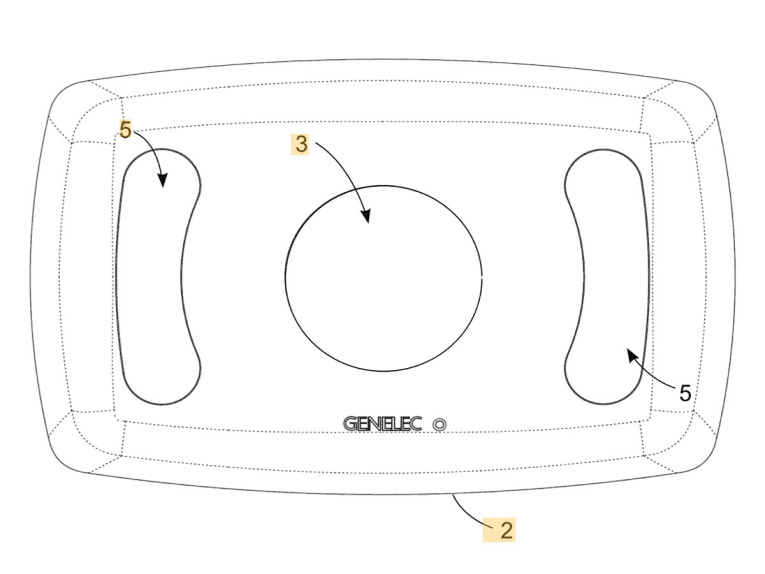
Reviewer Comments
Maintaining constant directivity over the majority of the operating range has become a well-known design target for high-quality loudspeakers. If it is achieved, it is accomplished, at a minimum, through the cross over region, where it avoids a rough transition that can result in “tweeter-flare” or off-axis room response that can have an amplitude spike in a critical portion of the midrange causing coloration in the room response.
While achieving a smooth transition through the crossover frequency is considered a minimum requirement for good sound quality, and can be accomplished fairly easily in modern loudspeaker design, achieving the benefits of constant directivity over the majority of a loudspeaker’s operating range is not an easy task. One approach is to use a constant directivity waveguide for the high frequencies down to a woofer and/or midrange driver, below which the woofer ‘discontinues’ the constant directivity below the cross over frequency and increases dispersion more as the output frequency is reduced.
Although constant directivity through the crossover frequency can help avoid abrupt transition coloration, a falling directivity with lower frequency causes a shift in the power response with frequency, which causes a non-ideal tilt in the room response.
This patent application discloses a new system developed by Genelec that attempts to address this issue. The basic system, used in the new Genelec model 8351, includes a 130-mm coaxial midrange with a 19-mm tweeter mounted in the center, with a cross over at 2.6 kHz. The coaxial combination is mounted in a waveguide’s center that expands from the coax to cover the majority of the rectangular, 452mm tall × 287mm wide enclosure’s frontal surface. While this part of the system can provide reasonably good directivity control to approximately 1.35 kHz horizontally, and 850Hz vertically, the preference is to maintain directivity to an even lower frequency, in at least one plane.
To extend vertical directivity, as disclosed in the patent (and the Genelec datasheet), the Genelec system adds an oval 215-mm by 100-mm woofer at each of the top and bottom ends of the enclosure, with the output of each of those woofers exiting out of a small (approximately 13 mm) slot running the width of the cabinet. This provides an additional pair of acoustic output sources at each end of the enclosure with a center-to-center separation of approximately 432 mm (17”). The woofers come in and extend down in frequency from 500 Hz to the lower limit of the system (claimed –6 dB at 32 Hz).
Besides providing the system’s low-frequency capability, the two slots interact with the waveguide over about half-octave, and then operate independently to maintain substantially constant directivity down to about 280 Hz. This type of spaced, dual source aperture can result in a simple and efficient means to enhanced directivity control. While a well-designed waveguide may maintain directivity down to about one-wavelength of its largest dimension, and a woofer, of the same active source diameter, can substantially match the directivity of a waveguide of the same dimension, a dual-point source, or slot source, can maintain the same level of directivity control to a frequency approximately 1-octave lower. At a plus-and-minus 90° angle from the zero-axis, a dual source will exhibit a cancellation null in the response at the frequency of which the center-to-center spacing is 0.5-wavelength, while exhibiting greater directivity between the 0.5-wavelength and one-wavelength frequency than a single source of the same dimension. So, in a small package that would normally only sustain directivity to a frequency at least an octave higher, this system can maintain very good constant directivity to a lower frequency, in one plane.
This reviewer has found that when working to develop constant directivity systems extending below that of the 1-wavelength limit of a waveguide or transducer dimension, one can deploy hybrid, transitional configurations incorporating a ring-slot source (0.786-wavelength) concentrically surrounding the outer dimension of a driver or waveguide, to maintain constant directivity in both the horizontal and vertical (and oblique) planes, and optionally transition to constant directivity to an even lower frequency application of a spaced, dual acoustic, or rectangular slot or properly oriented quad point sources.
The approach disclosed in the patent, and similar spaced source configurations, can be effective in providing frequency-extended directivity control without the need for large, 1-wavelength-based sources. The enhanced, vertical directivity arrangement used in the new Genelec 8351 should be useful, particularly in minimizing floor and ceiling reflections, which can cause a lower midrange cancellation null and also result in correlated midrange comb-filtering. VC
This article was originally published in Voice Coil, February 2015.




